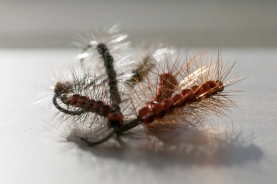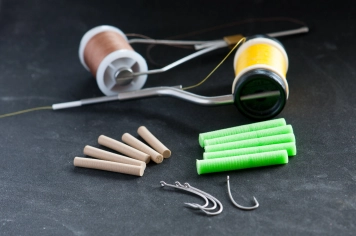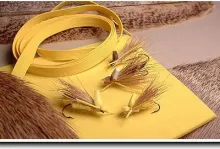Caterpillars aren't the most common type of fishing flies, but like a good ant or beetle pattern they can be killers by an overgrown stream bank on a warm summers day.
I was inspired to write this after seeing these great flies on Facebook where they were tied beautifully by Spanish fly-tyer Joaquín L. Quintás. Using few and simple materials, a simple technique and great colors he produced some excellent caterpillar imitations.
Caterpillars aren't
the most common flies to fish, but in stream stretches through forests and on overgrown banks they can be just as useful as a good ant or beetle pattern. We have featured the green inchworm here, tied by Argentinean Pedro Alfredo Miles, but the caterpillar is slightly larger and first and foremost characterized by its hairy appearance imitated with a dry fly hackle and giving the foam fly a very realistic look.
Apart from the foam, the keys to getting the caterpillar right are colored markers, good dry fly hackle and the right - but very-easy-to-master - tying technique.
Quintás uses cylindrical foam
for his caterpillars while Miles simply uses a strip cut from a foam plate for his inchworm.
I had no cylindrical foam at first, but loads of foam sheets, so I started out with a generic caterpillar pattern using the easier-to-find sheets. If you cut a narrow strip and tie it down with tight turns, it becomes almost cylindrical. The body becomes skinny compared to a natural, but useable.
You tie in the hackle in the rear. If you use a foam strip rather than a cylinder, you tie in the foam strip pointing backwards and fold it forwards, tie it down to form the first segment, lift and take the thread a bit forward, tie another segment, lift and so on.
The natural larva have dozens
of really narrow segments, which can be difficult to imitate precisely, but less can do. I typically get about 8-10 segments on a size 4 hook, and I'm sure it looks segmented enough for the fish to be fooled.
It's easier to get narrow segments when the foam is a cylinder, which is simply ribbed with the tying thread in close turns.
If you use cylindrical foam, cut a slit in it and press it over the hook shank and wrap over it in semi-tight turns to compress it and form segments. You can add a bit of glue to the shank first to secure the foam better than the loose tying thread does.
I'm sure it looks segmented enough for the fish to be fooled
Cut or melt the foam to form a head.
Many caterpillars have pronounced black heads, typically smaller diameter than the body. You can consider either switching to a black thread or using a black marker to dye the thread before the final wraps or simply mark the foam itself when the fly is done.
You can use markers to give the foam different accents, spots or stripes. Many caterpillars are very colorful and have beautiful contrasting patterns, and you are almost free to play as you please, because it's almost impossible to outdo nature when it comes to patterns and colors. You can of course look at the most common caterpillars in your area and take your cue from there.
Wrap the hackle forward in the grooves in the foam and tie it down, trim and whip finish and you have a nice caterpillar. Again you need not be modest. Many natural caterpillars are very hairy, and an ordinary dry fly hackle wrapped 6-8 times will not be an exaggeration.
The naturals float like corks
thanks to the hairs, and these flies are similarly high floating. They are fished on a floating line with the fly is best tied to the tippet using a loop knot, allowing the fly to move and wiggle a bit, indicating some struggle in the surface. Cast it close to the bank, preferably under branches sticking out over the water, maybe cutting under the branches using a very flat cast with the line arcs horizontal and close to the surface. You can simply dead drift the fly, but a twitch induced into the fly line by tapping the rod just above the handle, can give some sudden but small jerks in the fly, which enhances the impression of an animal fighting the water. Wiggling the rod tip can also induce some motion in the fly, which is of course pretty lifeless as it is.
- Log in to post comments














Rainy's
Skip,
Rainy's is your friend when it comes to foam. They have it all... and more.
Martin
I love this fly, Gre
I love this fly, Great job. Does anyone have a source for the small foam cylinders in various colors? I can't seem to find them. Thank you
Skip
Great work. Thanks f
Great work. Thanks for the sharing.